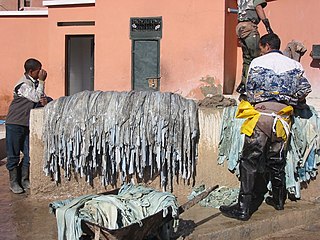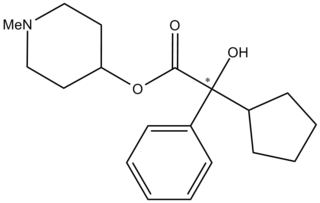A bactericide or bacteriocide, sometimes abbreviated Bcidal, is a substance that kills bacteria. Bactericides are disinfectants, antiseptics, or antibiotics.

Sulfur mustard, commonly known as mustard gas, is the prototypical substance of the sulfur-based family of cytotoxic and vesicant chemical warfare agents known as the sulfur mustards, which can form large blisters on exposed skin and in the lungs. It was also used as a weapon in World War 2. They have a long history of use as a blister-agent in warfare and, along with organoarsenic compounds, are the most well-studied of such agents. Related chemical compounds with similar chemical structure and similar properties form a class of compounds known collectively as sulfur mustards or mustard agents. Pure sulfur mustards are colorless, viscous liquids at room temperature. When used in impure form, such as warfare agents, they are usually yellow-brown and have an odor resembling mustard plants, garlic, or horseradish, hence the name. The common name of "mustard gas" is considered inaccurate because the sulfur mustard is not actually vaporized, but dispersed as a fine mist of liquid droplets. Sulfur mustard was originally assigned the name LOST, after the scientists Wilhelm Lommel and Wilhelm Steinkopf, who developed a method of large-scale production for the Imperial German Army in 1916.

Vitiligo is a long-term skin condition characterized by patches of the skin losing their pigment. The patches of skin affected become white and usually have sharp margins. The hair from the skin may also become white. The inside of the mouth and nose may also be involved. Typically both sides of the body are affected. Often the patches begin on areas of skin that are exposed to the sun. It is more noticeable in people with dark skin. Vitiligo may result in psychological stress and those affected may be stigmatized.

Tanning is the process of treating skins and hides of animals to produce leather. A tannery is the place where the skins are processed.

Winemaking or vinification is the production of wine, starting with the selection of the fruit, its fermentation into alcohol, and the bottling of the finished liquid. The history of wine-making stretches over millennia. The science of wine and winemaking is known as oenology. A winemaker may also be called a vintner. The growing of grapes is viticulture and there are many varieties of grapes.

Dandruff is a skin condition that mainly affects the scalp. Symptoms include flaking and sometimes mild itchiness. It can result in social or self-esteem problems. A more severe form of the condition, which includes inflammation of the skin, is known as seborrhoeic dermatitis.

Erythema is redness of the skin or mucous membranes, caused by hyperemia in superficial capillaries. It occurs with any skin injury, infection, or inflammation. Examples of erythema not associated with pathology include nervous blushes.

A blister agent, or vesicant, is a chemical compound that causes severe skin, eye and mucosal pain and irritation. They are named for their ability to cause severe chemical burns, resulting in painful water blisters on the bodies of those affected. Although the term is often used in connection with large-scale burns caused by chemical spills or chemical warfare agents, some naturally occurring substances such as cantharidin are also blister-producing agents (vesicants). Furanocoumarin, another naturally occurring substance, causes vesicant-like effects indirectly, for example, by increasing skin photosensitivity greatly. Vesicants have medical uses including wart removal but can be fatal if even small amounts are ingested.

Clobetasol propionate is a corticosteroid of the glucocorticoid class used to treat various skin disorders including eczema and psoriasis. It is also highly effective for contact dermatitis caused by exposure to poison ivy/oak. Clobetasol belongs to US Class I of the corticosteroids, making it one of the most potent available. It comes in shampoo, mousse, ointment and emollient cream presentations. It has very high potency and typically should not be used with occlusive dressings, or for extended continuous use. It is also used to treat several autoimmune diseases including alopecia areata, lichen sclerosus, and lichen planus.

Emollients are cosmetic preparations used for protecting, moisturizing, and lubricating the skin. These functions are normally performed by sebum produced by healthy skin. The word "emollient" is derived from the Latin verb mollire, to soften.

Chlormethine, also known as mechlorethamine, mustine, HN2, and embikhin (эмбихин), is a nitrogen mustard sold under the brand name Mustargen. It is the prototype of alkylating agents, a group of anticancer chemotherapeutic drugs. It works by binding to DNA, crosslinking two strands and preventing cell duplication. It binds to the N7 nitrogen on the DNA base guanine. As the chemical is a blister agent, its use is strongly restricted within the Chemical Weapons Convention where it is classified as a Schedule 1 substance.

Dermatophytosis, also known as ringworm, is a fungal infection of the skin. Typically it results in a red, itchy, scaly, circular rash. Hair loss may occur in the area affected. Symptoms begin four to fourteen days after exposure. Multiple areas can be affected at a given time.

Erythroderma is an inflammatory skin disease with redness and scaling that affects nearly the entire cutaneous surface. This term applies when 90% or more of the skin is affected.

Desoximetasone is a medication belonging to the family of medications known as topical corticosteroids. It is used for the relief of various skin conditions, including rashes. It helps to reduce redness, itching, and irritation. Desoximetasone is a synthetic corticosteroid, a class of primarily synthetic steroids used as anti-inflammatory and anti-pruritic agents.
ICD-10 is an international statistical classification used in health care and related industries.

A lentigo is a small pigmented spot on the skin with a clearly defined edge, surrounded by normal-appearing skin. It is a harmless (benign) hyperplasia of melanocytes which is linear in its spread. This means the hyperplasia of melanocytes is restricted to the cell layer directly above the basement membrane of the epidermis where melanocytes normally reside. This is in contrast to the "nests" of multi-layer melanocytes found in moles. Because of this characteristic feature, the adjective "lentiginous" is used to describe other skin lesions that similarly proliferate linearly within the basal cell layer.
Skin whitening, also known as lightening, brightening, depigmentation, and bleaching is the use of substances, mixtures, or physical treatments to lighten skin color. Skin whitening treatments work by reducing the skin's melanin content. Many agents have been shown to be effective in skin whitening. Some agents have beneficial side effects, including supplying antioxidants or nutrients or reducing the risk of some types of cancer. Other agents are a significant risk to health, such as mercury-based methods.

A lotion is a low-viscosity topical preparation intended for application to the skin. By contrast, creams and gels have higher viscosity, typically due to lower water content. Lotions are applied to external skin with bare hands, a brush, a clean cloth, or cotton wool.
Candidal onychomycosis is an infection of the nail plate by fungus caused by Candida. In one study Candida parapsilosis was the most common species; Candida albicans is also a common agent.

EA-3443 is a potent and long lasting anticholinergic deliriant drug, related to the chemical warfare agent 3-Quinuclidinyl benzilate (QNB). It was developed under contract to Edgewood Arsenal during the 1960s as part of the US military chemical weapons program, during research to improve upon the properties of earlier agents such as QNB.


















